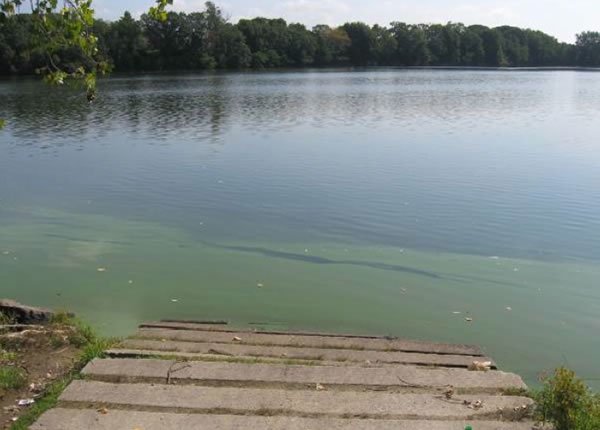Jump in? Not So Fast! Impact of Cyanobacteria Blooms on Recreational Waters
Summer is fast approaching and with the warm weather it is time to hit the water! Clean water and access to safe waterbodies play an important role in our communities. They enable individuals of all ages to have fun while also improving mental and physical health, strengthening social bonds, and boosting local economies. In addition to providing recreational use, waterbodies often carry strong cultural and spiritual value for many communities. For many indigenous communities, local waterbodies are sacred places that must be preserved and protected. To others, places near the water serve as a meditative place where they can reconnect with nature.

Unfortunately, access to waterbodies is sometimes restricted or closed due to harmful algal blooms (HABs). This phenomenon may occur when water temperatures increase in areas of high nutrient levels, which drives photosynthetic organisms to grow exponentially and create noticeable blooms. Often these blooms are unsightly but don’t hamper their use for recreation, but sometimes they are dominated by organisms that produce toxins harmful to human and animal health.
Harmful algal blooms are a growing concern as they are increasing in frequency and duration in many fresh and brackish waters1. These blooms are often produced by cyanobacteria (also known as “blue-green algae”). Cyanobacteria have an ancient evolutionary history during which they played a major role in shaping the composition of our atmosphere. They were the first organisms on earth to photosynthesize, using H2O and sunlight to fix carbon, and produce oxygen as a waste product. So, we can thank cyanobacteria for creating an atmosphere we can thrive in. They are part of the natural microbial communities in aquatic ecosystems, but anthropogenic disturbances have tipped the usual balance and increased their occurrence in fresh and brackish water ecosystems worldwide1,2,3. Cyanobacteria thrive in warm, nutrient rich water, and the nutrient loads coming from our farms and cities makes it easier for cyanobacteria to outcompete other microbial organisms and bloom2,3. Altering natural hydrology by decreasing the rate of flow into waterbodies or altering the food web by removing or introducing species also seem to increase cyanobacteria blooms3. And critically, warming waters due to human-induced climate change are projected to increase the frequency and duration of blooms1,2,3.
The main problem with cyanobacteria blooms is that they can produce toxins that affect humans, pets, and wildlife. If a person or pet ingests or has direct contact (e.g. swimming), with cyanotoxins, it can affect their liver, neurological system, or skin.Exit Because cyanobacteria could potentially be toxic, access to recreational waters may be restricted or temporarily suspended by state or local authorities if a bloom occurs; better safe than sorry. Closure of ponds and lakes deprives communities of the multiple recreational benefits they provide, and affect local economies by impacting tourism, summer camps, city planned recreational water activities, and even real estate. Exit
What can we do about it?
While there is no easy solution to remove or treat the blooms, there are multiple steps we can take to manage waters prone to cyanobacteria blooms. One is increasing awareness of health risks associated with cyanotoxins and the causes of blooms. Education and community outreach can help every individual in the community understand what cyanobacteria are, why they occur, and why they pose a threat to human and pet health. Another step we can take to reduce cyanobacteria blooms in the future is to implement best management practices (BMPs) in our towns and cities to reduce nutrients loading into our watersheds.
And lastly, we can increase monitoring to better understand when the blooms are happening, where, how long, and what type of cyanobacteria dominates the blooms to better inform our communities about potential health risks and to help assess whether a pond or lake should be closed.

To assist communities and municipalities to adopt or enhance cyanobacteria monitoring programs, the Southeast New England Program (SNEP) is working with the Cyanobacteria Monitoring Collaborative (CMC) to provide training to monitoring groups (municipalities, tribes, citizen scientist groups) throughout the SNEP region and enable them to join the collaborative. The CMC is made up of three coordinated monitoring programs. The first one – BloomWatch -- is a phone application that can be used by anyone who wants to report a bloom. Pictures and data collected from the app will be used to understand regional trends (where, when, and how long a bloom occurs).
Cyanobacteria monitoring training in Wrentham hosted by the Lake Archer Association. Training provided by Hilary Snook and Corey Conville from the USEPA Region 1 Lab, and Shasten Sherwell an ORISE Fellow with USEPA SNEP.
- Griffith, A. W., & Gobler, C. J. (2020). Harmful algal blooms: a climate change co-stressor in marine and freshwater ecosystems. Harmful Algae, 91, 101590.
- Paerl, H. W., & Huisman, J. (2009). Climate change: a catalyst for global expansion of harmful cyanobacterial blooms. Environmental microbiology reports, 1(1), 27-37.
- Paerl, H. W. (2018). Mitigating toxic planktonic cyanobacterial blooms in aquatic ecosystems facing increasing anthropogenic and climatic pressures. Toxins, 10(2), 76.
Jump in? Not So Fast! Impact of Cyanobacteria Blooms on Recreational Waters (pdf)
